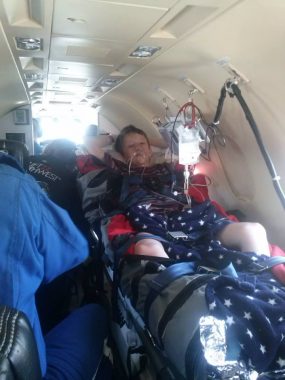The Old Memories of Flying With PH Still Linger

My son had just been diagnosed with severe pulmonary arterial hypertension (PH), and he had a wish — and it involved flying.
“I would like to meet George W. Bush, the president of the United States,” said then 8-year-old Cullen, to the surprise of the Make-A-Wish (MAW) Foundation granters in 2008. As I wrote in a previous column, “I thought he might as well have asked the foundation to cure his PH, because meeting the president seemed so unlikely.” It also felt unlikely that his doctor would give him the thumbs-up to fly across the country from Washington state to Washington D.C.
Along with his oral PH treatments, Cullen was about to start Flolan (epoprostenol GM), so his doctor asked us to delay the trip for a couple of months. He hoped that, by then, the combination therapy would have him feeling a lot better.
He was right, and to Cullen’s delight, MAW granted his wish! Cullen, Mom, Dad, and Brother flew to Washington D.C., and we all had the honor of meeting President Bush on Oct. 30, 2008.
Flying with PH can be done
Based on our experience, and what I have heard from other patients and caregivers, flying with PH is not impossible, but it can be risky and stressful. Thorough planning is crucial to protect the patient and to make sure airline policies are observed, and we consulted often with his doctor, who provided a letter and medical summary to help ease us through airport security with Cullen’s medications and his central venous catheter and Flolan pump.
One risk of flying with PH is hypoxemia due to low cabin pressure and other conditions. For this reason, MAW and Cullen’s doctor arranged for supplemental oxygen to be available on the flight, even though he usually only needed it when he slept. This precaution also helped ease some of Cullen’s preflight jitters, and the flight there and back went well.
Cullen has flown three more times since then — not for fun, but because his disease was getting worse. There was an emergency flight by helicopter during a PH crisis, and a commercial airline flight for what turned out to be a transplant dry run.

Cullen flies to California on Aug. 6, 2014, ahead of his heart and double-lung transplant. (Photo by Colleen Steele)
The final PH flight was the most frightening for Cullen. He was extremely sick, and was airlifted from Seattle Children’s Hospital to Lucile Packard Children’s Hospital in California. It was here that he received his lifesaving heart and double-lung transplant. While the medical flight crew was wonderful, the experience of flying in critical condition was traumatic for him, and it has continued to linger in the back of his mind like a ghost.
A flight for fun, but bad memories remain
Last week, Cullen got to fly again for the first time since his transplant seven years ago. He went with me to New Jersey to visit his grandparents, and I could tell that that bad experience was on his mind, even though he is healthier than he has ever been. It was on my mind, too.
Walking through the airport, I kept asking, “Are you OK?” When he offered to pull two suitcases, I asked, “Are you sure?” He gently assured me that if he were having problems and needed help, he would tell me.
Like previous flights, we carefully planned. Cullen read the airline policies to make sure he could keep his many medications in his carry-on. It turns out the airline recommends doing that as long as the medicine is not in liquid form.
Luckily, Cullen was able to take his medications before we boarded. There was a lot of turbulence on the flight, which caused the flight crew to delay serving beverages. For the flight back to Washington on Dec. 15, we will purchase a bottle of water and a small snack in case he’s midflight when it is time to take his medications.
Arranging an early arrival time so Cullen could relax before boarding also helped calm him for the flight. Once we boarded, it was a relief that everyone on the flight willingly wore their masks. He was able to distract himself by looking out the plane window, but when turbulence hit after it got dark and there wasn’t anything to look at, I noticed he started bouncing his knee.
He said what helped him get through it was a trick he learned years ago from the TV show “Unbreakable Kimmy Schmidt.” The main character, Kimmy, was rescued from a doomsday cult and started life over again in New York City. Her mantra was that anyone can put up with anything for 10 seconds. “Count to 10 and, when you’re done, start again,” she’d say.
That is what Cullen did. He got through the turbulence 10 seconds at a time. He says he wonders how much that trick might have helped him if he had known it when he was flying with PH.
***
Note: Pulmonary Hypertension News is strictly a news and information website about the disease. It does not provide medical advice, diagnosis, or treatment. This content is not intended to be a substitute for professional medical advice, diagnosis, or treatment. Always seek the advice of your physician or other qualified health provider with any questions you may have regarding a medical condition. Never disregard professional medical advice or delay in seeking it because of something you have read on this website. The opinions expressed in this column are not those of Pulmonary Hypertension News or its parent company, Bionews, and are intended to spark discussion about issues pertaining to pulmonary hypertension.









Tony Edward Wiley
I was really surprise, i had no problem flying. great trip.
Colleen Steele
Tony, I would love to hear more about your positive flying experience. If you haven't already, I encourage you to join the PH forums. Maybe you can share tips with our members about how to fly with PH.
Thank you for reading!